Part 4: - Beginning The Campaign
Beginning The CampaignNote that this update will be quite wordy - I need to explain pretty much everything in the game bar a few things that come later. There's no real learning period with this game, every week is crucial.
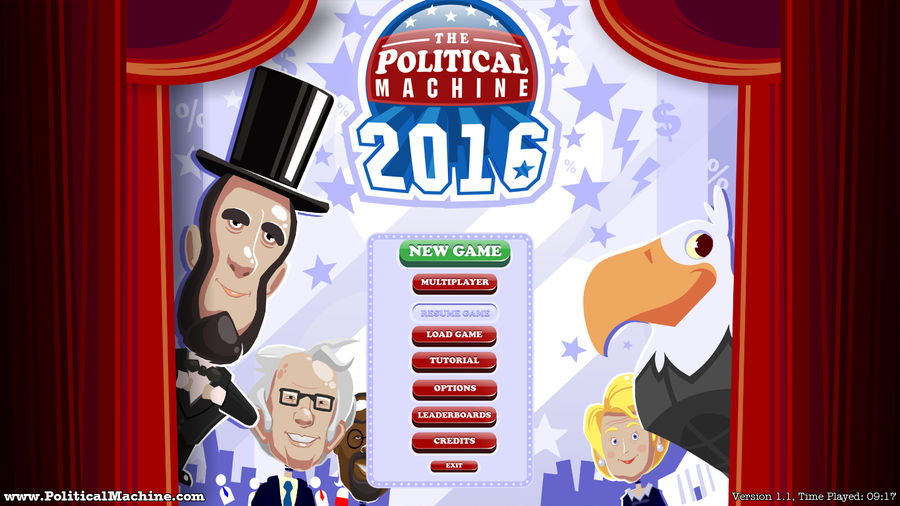
First, let's set up our game.
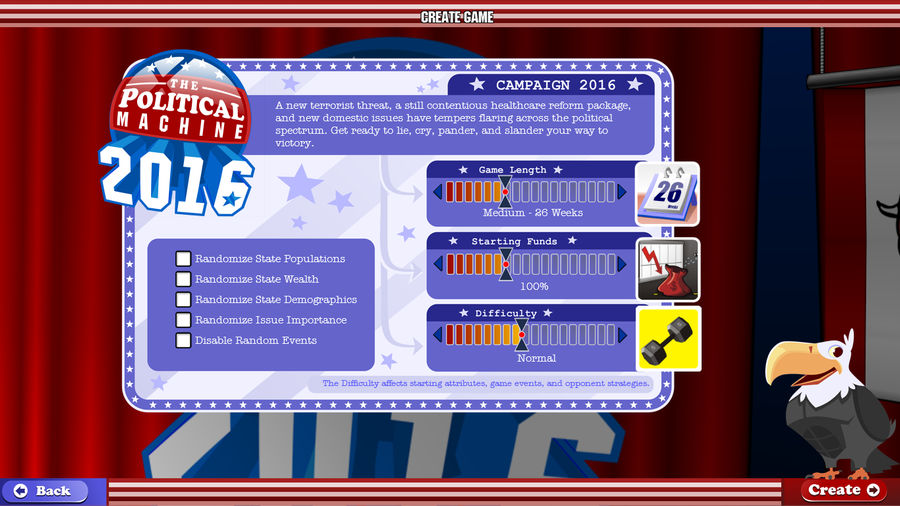
This is what I assume the closest thing to a normal game to be. Everything set to "normal" values and the defaults are kept for the checkboxes. FYI, "random events" are things that happen that drastically alter the issue importance across the nation - so, for instance, a major war could erupt overseas, which would raise the importance of the issue "A Strong Military". However, these events are very rare, and I personally have not seen one happen yet. Of course, this could mean that this game will be the one, but we'll see.
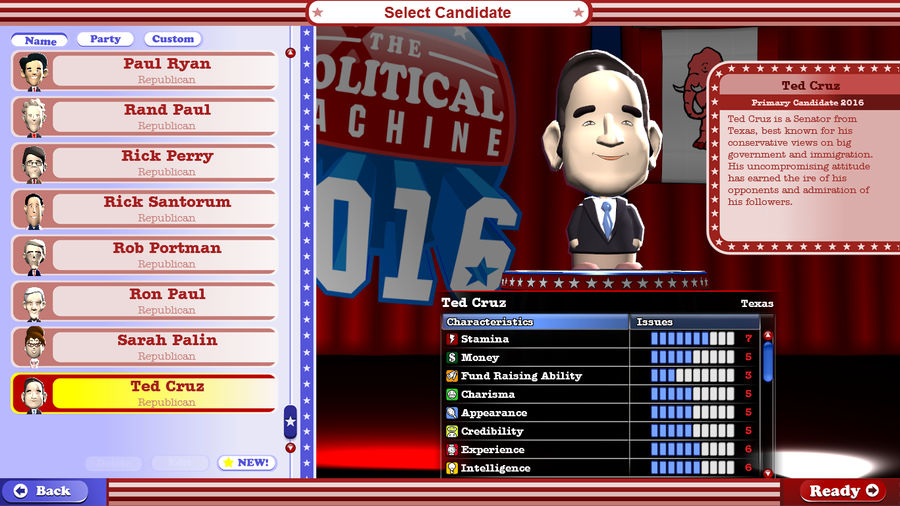
And as the thread has voted, our 2016 election will be contested between Zodiac Killer...
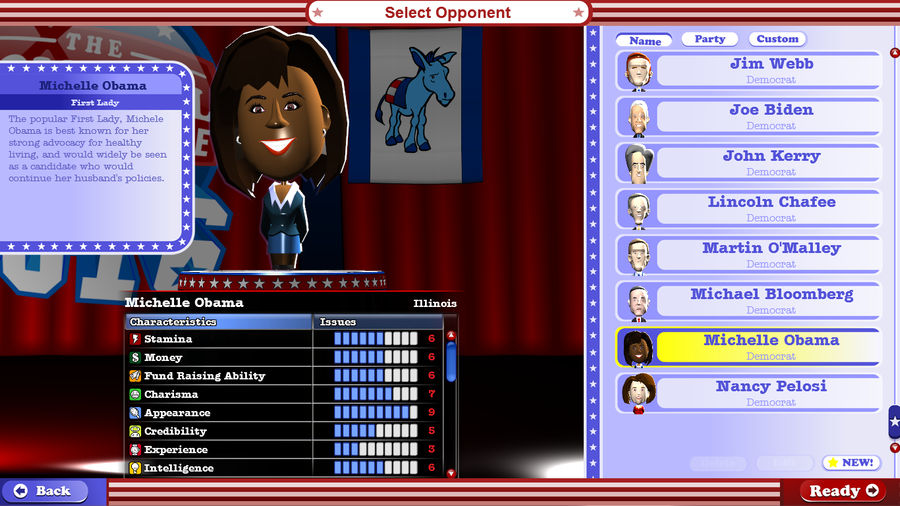
...and Michelle Obama.
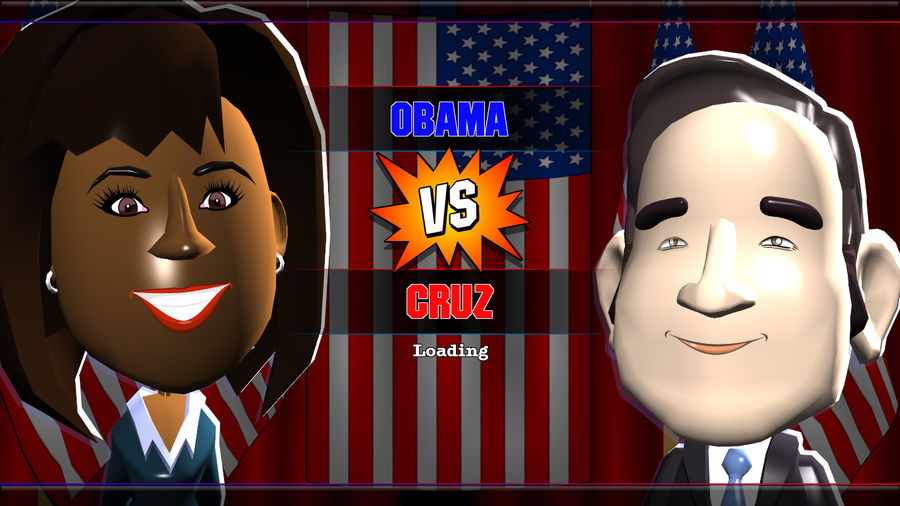
Now, this is where the fun begins.

We get a little introduction text...
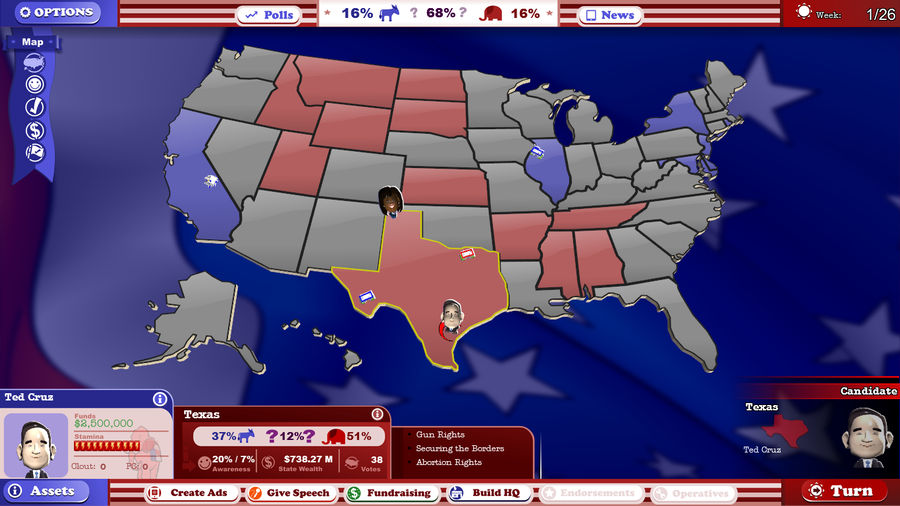
...and here we are! Welcome to The Political Machine 2016! This is the main screen of the game, the map of the United States with states colored in red, blue and gray, which shows which states lean which way. There's also stronger shades of red and blue for when states swing harder in one direction, but in the beginning, everything is still vague. Now, let's go over the information we have available on this screen.
- At the top, we see that currently, the vote is split 16% Democrat, 16% Republican, and 68% undecided. So things are a lot more wide open than they would be in real life, where a lot of people pretty much already have their mind made up.
- In the top right, we see what turn we're currently on. We have 26 weeks to convince the voting population that we're the best!
- In the bottom left, we have some information about our candidate. We have 2.5 million dollars in funds, 11 stamina points, 0 clout, and 0 political capital. We'll get to clout and political capital later.
- On the bottom, we see information about the state we currently have selected. From there, we can see that in Texas, the estimated Election Day vote is 37% Democrat, 51% Republican, and 12% that could go either way. Our awareness (basically how many people in the state know about us) is 20%, and Obama's awareness is 7%. We can see that Texas has a lot of wealth and electoral college votes, and the top three issues in the state are Gun Rights, Securing The Borders and Abortion Rights.
- And on the right, we see what we currently have our candidate selected. When we gain more operatives, we can select those too and move most of them around the map.
Furthermore, the game has multiple map modes.

In this map mode, states appear in brighter green the more awareness you have in that state. Awareness starts at a baseline of 5%, with your home state starting at 20% (so Texas for us, and Illinois for Obama). Also, many different things raise awareness, but we'll go over those when we get to the different things you can do in a state. One thing about awareness, though - just flying to a state raises awareness by 2%. This can be useful to do if you have money remaining (flying to a state costs 25K) and just one or two stamina points left over, since there's nothing you can do with that.
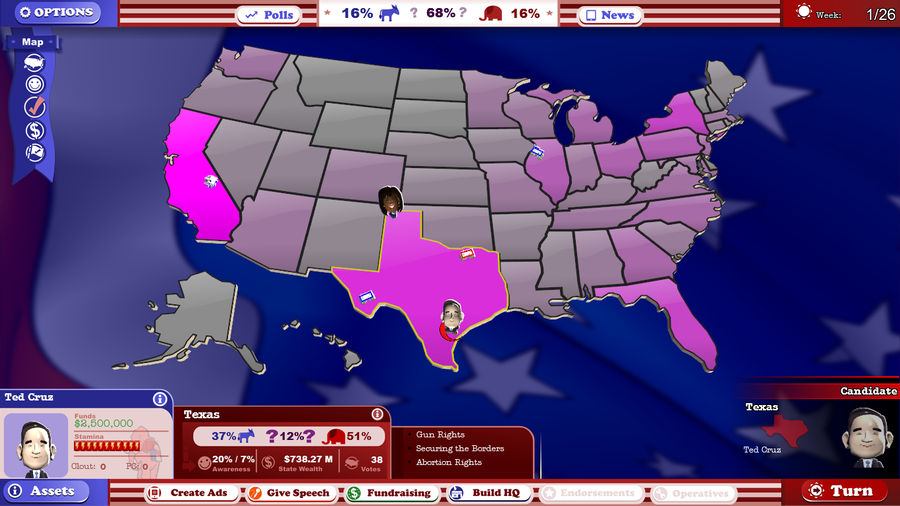
This map mode shows states with more electoral college votes in a brighter shade of pink, and I guess we should go over the electoral college for our outsider friends that might not know about it yet. The easiest way I can explain it is that the amount of votes you win in the entirety of the United States doesn't count for anything. What really counts is the electoral college votes, and they work by assigning every state in the USA a certain number of electors. The one that gets the majority of the vote in a state wins the votes of the electors of that state. Or in very simple terms - every state is worth a certain amount of points, and you need to win the majority of the points to win the election.
I don't like this map mode - after the clear frontrunners in California and Texas, and the clear seconds in New York and Florida, everything gets really muddled - I guess that's fitting, but it's hard to read. Instead, I made a spreadsheet that has all the information on which state is worth how many votes, amongst other things. I'll be referring to this spreadsheet a lot - it'll have all the information you'll need to run a good campaign.
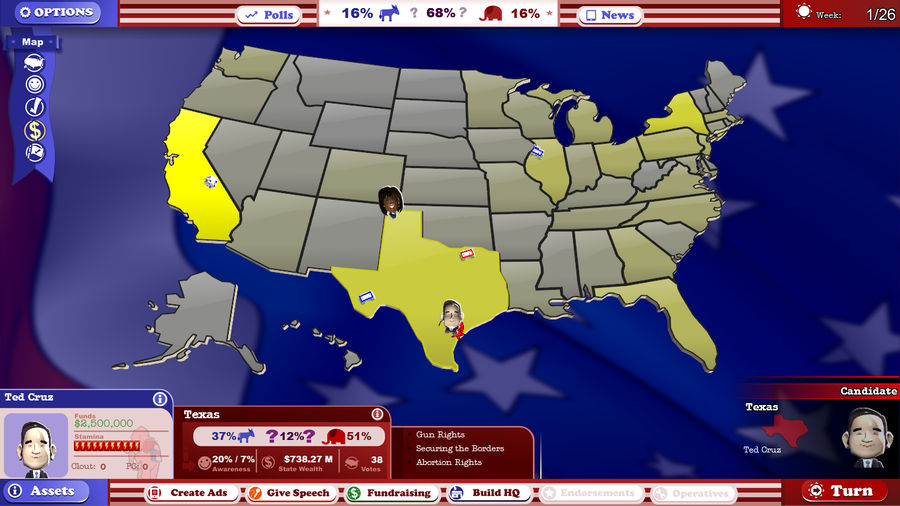
This map mode shows state wealth, which only comes into play when it comes to fundraising. Again, things get really muddled after the few frontrunners, so again, just refer to the spreadsheet for information on that.
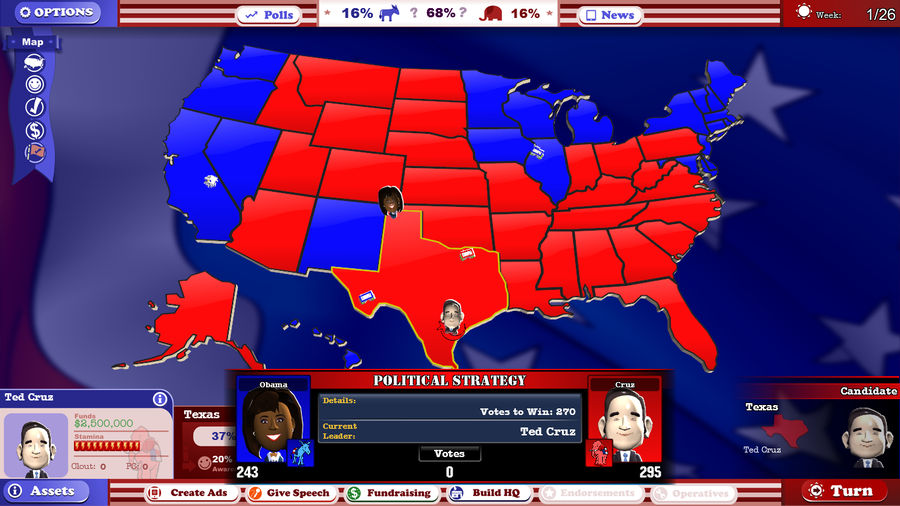
Finally, we have the "political strategy" map mode. This allows you to flip states to Republican or Democrat control and see how the electoral votes line up in that scenario. I never use this, but I guess if some of you get a strategy together, I can set that up.
Now, let's take a look at our candidates again.
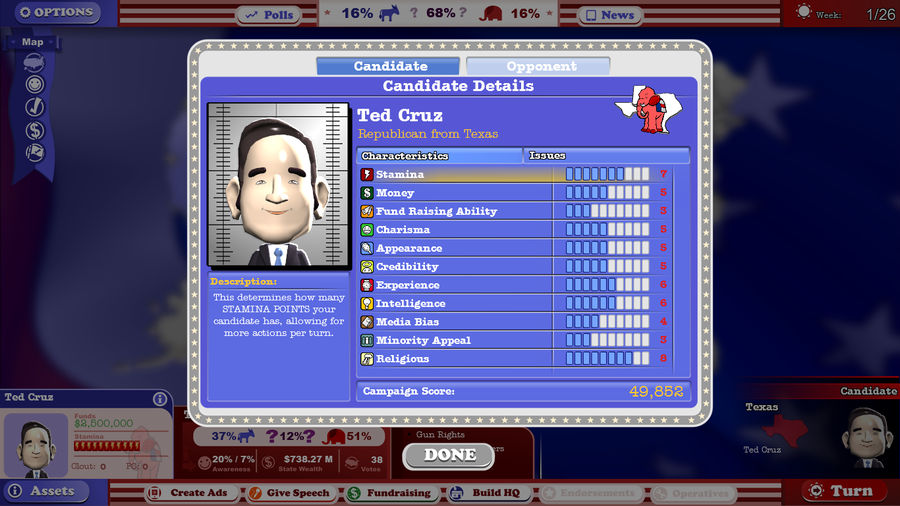
As a reminder, here are what the attributes do:
- Stamina: More Stamina means more stamina points, which you burn when you take actions.
- Money: More Money means that your initial funds are higher.
- Fund Raising Ability: More Fund Raising Ability means that your returns on fundraisers are higher.
- Charisma: More Charisma means that your speeches and ads are more effective.
- Appearance: More Appearance means that your interviews are more effective.
- Credibility: More Credibility means that your negative ads are more effective and your opponent's negative ads are less effective.
- Experience: More Experience means that you need less Political Capital points to win endorsements.
- Intelligence: More Intelligence means that your available responses during an interview are better.
- Media Bias: More Media Bias means the press likes you more, which means that it's easier to sway undecided/independent voters.
- Minority Appeal and Religious: More of these means that your awareness generated by campaign HQs is increased in areas with a large minority or religious demographic, respectively.
Cruz is largely average, but has weaknesses in Fund Raising Ability (which is bad, getting money is very important), Media Bias (which is eh, but really bad because of who we're facing), and Minority Appeal (which I don't think highly of, largely because it's very specialized - Charisma makes speeches and ads better, Minority Appeal just raises the awareness that is generated by campaign HQs, AND only in areas with a large minority demographic. Also, the game doesn't seem to tell you what those areas actually are). His strengths lie in Stamina (which is good) and Religious (which I also don't think highly of for the same reasons I don't like Minority Appeal).
And for comparison, here is Obama:
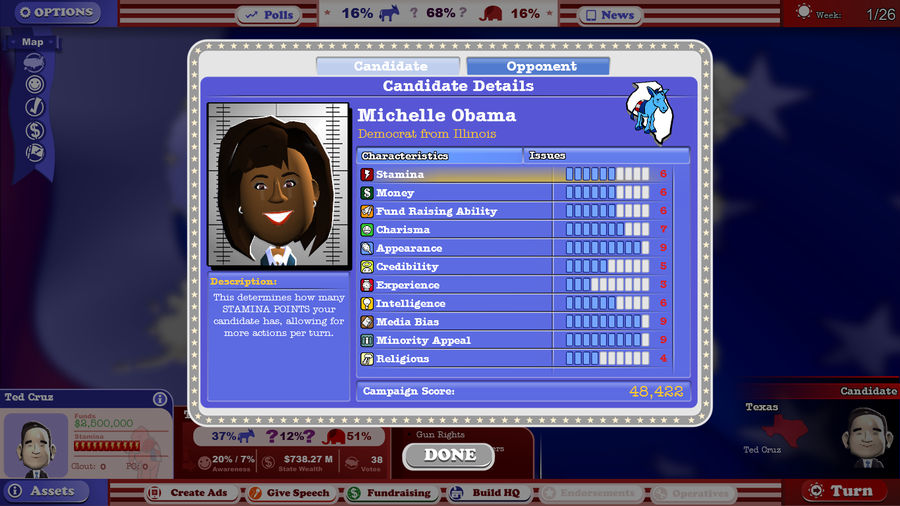
Hm. We beat her in Stamina, Experience and Religious. She beats us in Money, Fund Raising Ability, Charisma, Appearance, Media Bias and Minority Appeal, some of those by a long shot. This isn't looking good. Her ads and speeches will be better than ours, she'll have more money, her interviews will be better, and she'll be more likely to get undecided voters, and all we have to show for it is some more endorsements and slightly more actions per turn. Not a good look at all. Welp.
Now, we need to talk more about the central mechanic of the game - issues. Issues, and the scores candidates have on those issues are what every voter uses to decide who they vote for. In every state, there is a Democrat, Republican and Independent population, which each have their own opinions on all issues, and every state has a different set of issues that is important to them. For instance, let's compare Texas and California. Texas's top five issues are, in that order: Gun Rights, Securing The Borders, Abortion Rights, Supporting Gay Marriage and Big Government. California's top five issues are, in that order: Addressing Climate Change, Legalization Of Marijuana, Securing The Borders, Supporting Gay Marriage and Abortion Rights.
As for the different populations' opinions on those issues, as a general rule, just remember "Democrat = liberal, Republican = conservative". Republicans like things like Gun Rights and Securing The Borders and dislike things like Abortion Rights, Big Government or Supporting Gay Marriage. Democrats are generally the reverse - they like what Republicans don't like and vice versa. Independents, on the other hand, are more tricky - they have opinions that are more nuanced, depending on the state. So, for instance, Independents in Arizona like Securing The Borders, whereas Independents in California dislike it. In order to make that easier to work out, my spreadsheet will have a page with the top five issues and how the Independents in that state feel about it - green for support, gray for indifferent, red for opposing. I will update that page every four in-game weeks, so you'll have relatively up-to-date info on how awareness, voting projections and the importance of issues are developing.
Anyway, now that you've got a primer on issues, let's look at how the information is presented in-game.

First, we have the "Zagby" polls (a play off Zogby, a pollster in the USA), which give a national view on the issues. I think it shows how many voters think that that particular issue is the most important, and how many of those swing for either of the candidates - so you can see that we pick up a lot of the Resettlement Of Refugees, Fighting ISIS and Securing The Borders voters, but that's probably due to change as the campaign continues.
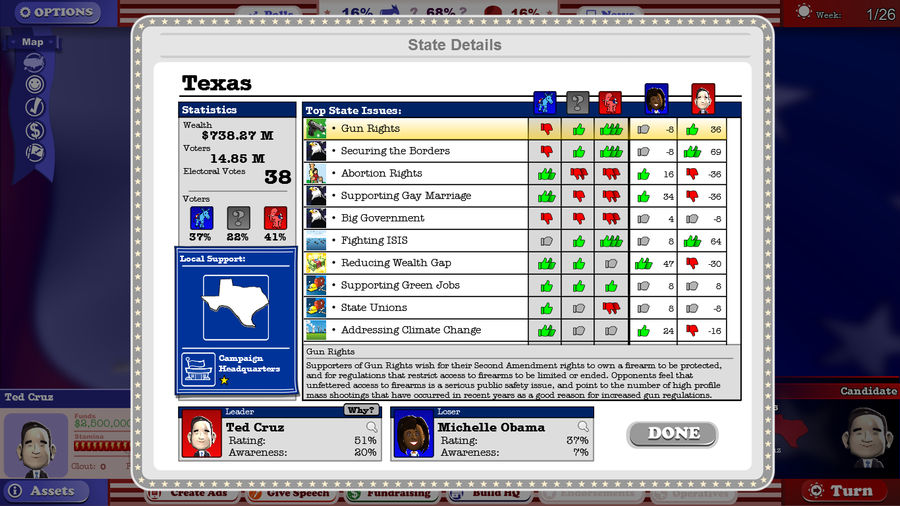
Now, we can take a look at Texas to see what information we can get from a state. We can see things like state wealth. electoral college voters, and the population Democrat/Independent/Republican split (which you can see in my spreadsheet), the amount of voters in the state (pointless), and most importantly, the issue scores and importances. I'll let the game explain what goes into winning a state:
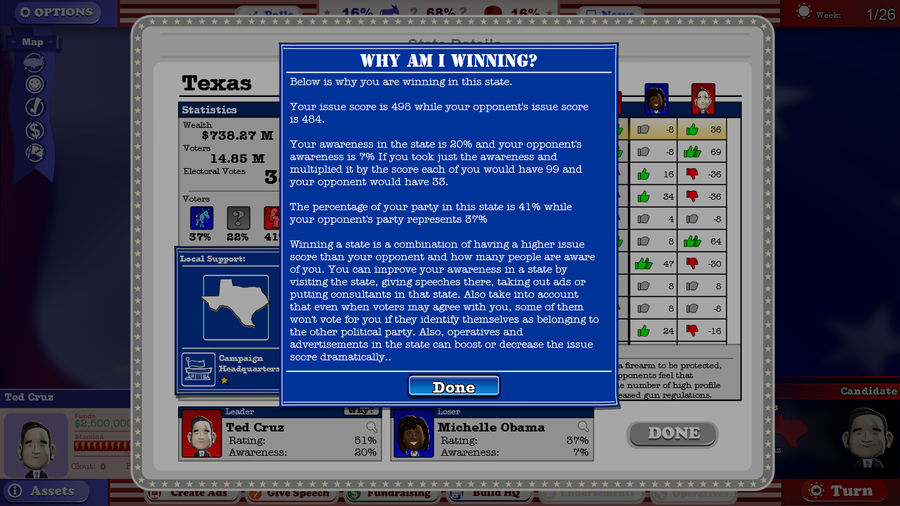
Basically, don't think of issue scores as positive and negative numbers. They're scores for "support" and "oppose", and depending on the voter group that you're trying to woo, that's positive or negative. So in Texas, where Republicans and Independents make up 63% of the population, opposing Abortion Rights, Supporting Gay Marriage and Big Government while supporting Gun Rights and Securing The Borders is a good thing. Now, on my spreadsheet, I wrote down the starting issue ratings for both our candidates on all issues. Your task is going to be to manipulate those issue scores depending on the state in order to woo as many voters as possible. How do you manipulate issue scores? Well, there are a few things you can do in a state that help you with that task.
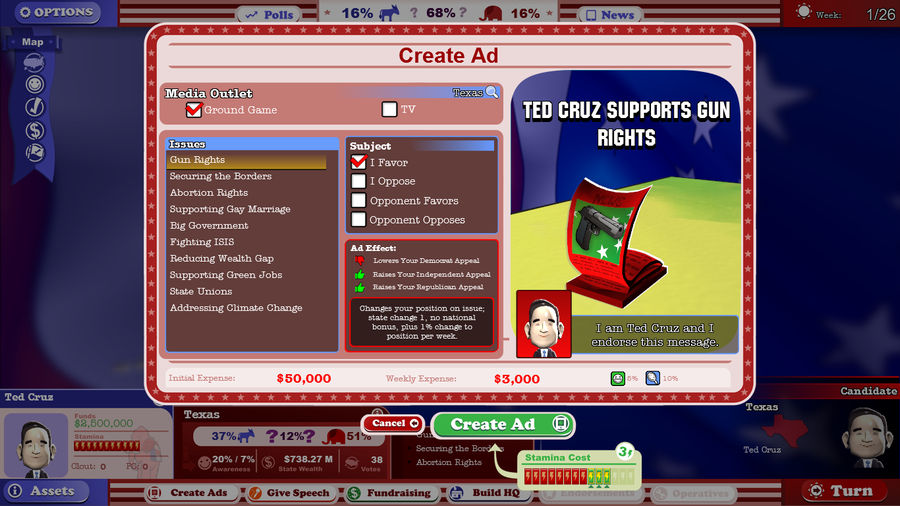
First of all, there are ads. Ads consist of you picking an issue and staking out the position you want to show in the ad - be it you supporting or opposing something, or your opponent supporting or opposing something. You can run multiple ads on the same issue, so you can run a one-two punch of showing you supporting *ISSUE* and your opponent opposing it - or vice versa, of course - but I don't believe running redundant ads is worth it, you should instead be using the money on running things on different issues to cover more bases. However, you can ignore that if you feel that running a single issue into the ground is more important (though I don't know if that even works, never tried it).
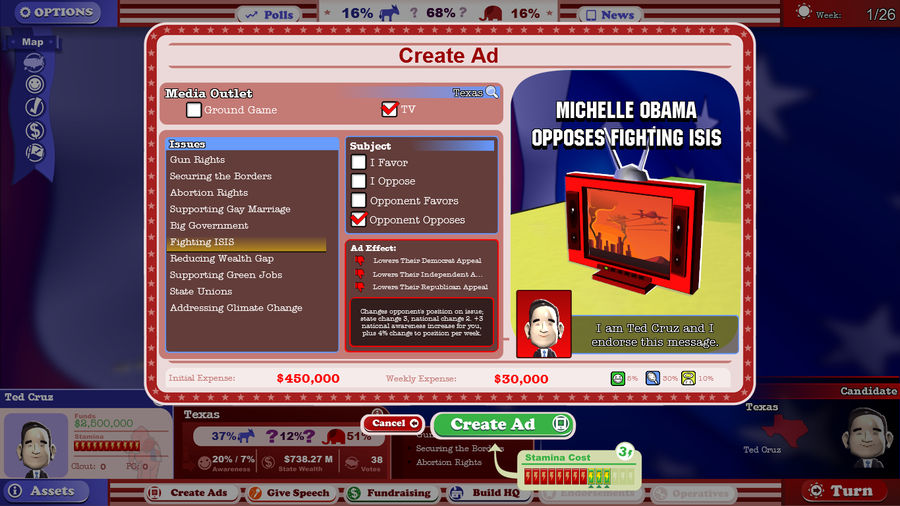
There are ground game ads (which only have a small effect on the state you're in, but cost drastically less) and TV ads (which have a stronger effect and work on a national level as well, but they cost a fuckton more, both to start out and to maintain every week). Regardless, running an ad costs you three stamina points.
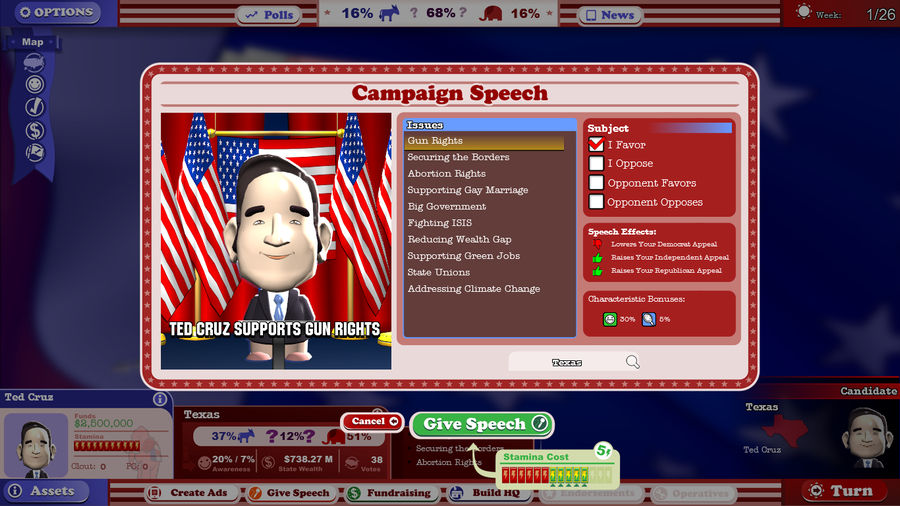
You can also give a speech on how you support/oppose or how your opponent supports/opposes a certain issue. This doesn't cost any money and gives you a good chunk of issue rating and awareness, but it costs five stamina points, which is a hefty chunk. Still, it's a useful tool when you're running low on cash and need to push your awareness higher for some fundraising.
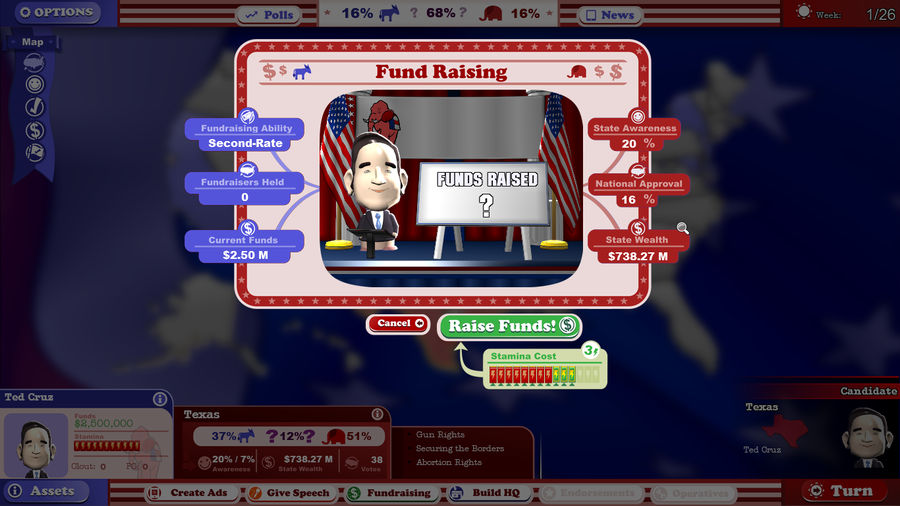
And that perfectly segues into the next thing you can do in a state - fundraising! Fundraising is a relatively simple concept - it costs three stamina points, and you get a certain amount of money based on state wealth, your awareness, and your fundraising ability. Now, here's a couple things I believe about fundraising. One: Don't fundraise in any but the top three to six wealthiest states, depending on game length. Not worth it. In our case, we can probably do well enough just fundraising in California, Texas and New York. Two: Don't fundraise when your awareness is lower than about 60%. Three: Don't be afraid to milk states. They say that repeated fundraisers will give you worse returns, but the gap between the top states and the next is so large that milking the top states is better than spreading yourself out. Four: Fundraising is non-partisan. Basically, what this means is that it doesn't seem to matter whether you're a Democrat or a Republican when you fundraise in certain states - so being a Republican in California should get you the same amount a Democrat would.

Finally, we can build buildings. You can build a single building in a state, and there are three types of building. We start with a campaign HQ in our home state, so we can only upgrade the one we have.
- Campaign HQ: This building gives us money every week, allows us to use more than the top five issues in the state, and gives us an awareness bonus in the state.
--- Level 1: 10,000$ per week, top 10 issues available in state, slight awareness bonus in state
--- Level 2: 30,000$ per week, top 15 issues available in state, moderate awareness bonus in state
--- Level 3: 90,000$ per week, all issues available in state, large awareness bonus in state
- Consulting Office: This building gives us Political Capital points, which are used to hire operatives.
--- Level 1: 1 Political Capital per week
--- Level 2: 3 Political Capital per week
--- Level 3: 7 Political Capital per week
- Outreach Center: This building gives us PR Clout points, which are used to gain endorsements, and gives us an awareness bonus in the state, and in the region if fully upgraded.
--- Level 1: 1 PR Clout per week, slight state awareness boost
--- Level 2: 3 PR Clout per week, state awareness boost
--- Level 3: 7 PR Clout per week, region awareness boost
It costs 250K to build a building at level 1, 500K to upgrade from level 1 to level 2, and 1 million to upgrade from level 2 to level 3. Building buildings early is important, since you want to maximize the benefit you get from these buildings, but you can very easily burn your money too fast.
We'll get to operatives and endorsements once we get enough political capital or PR clout to get some of those.
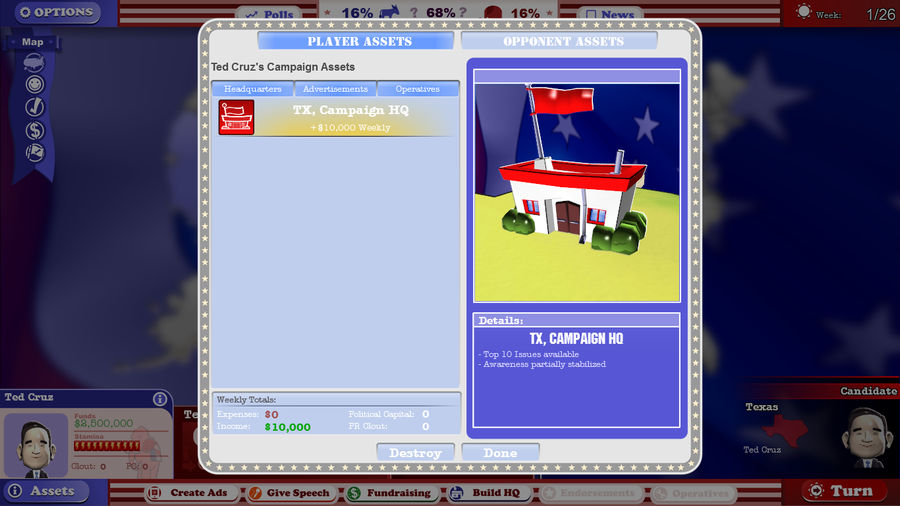
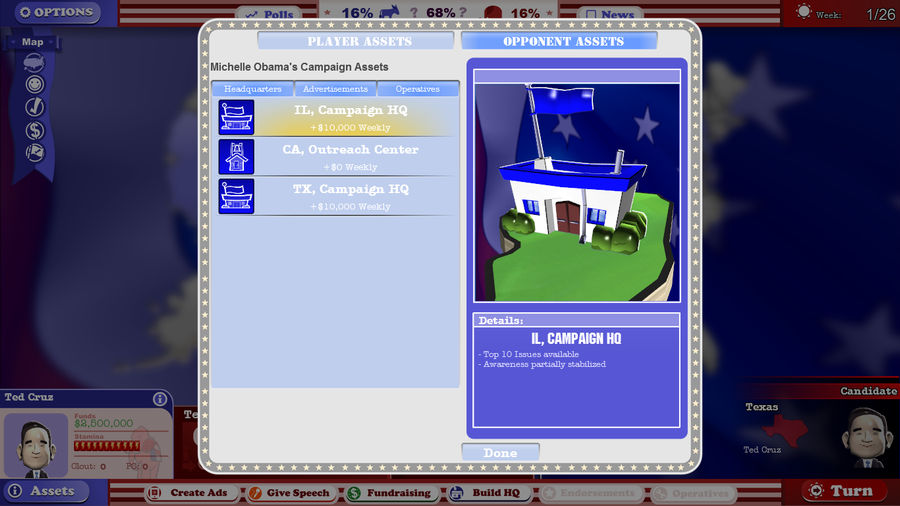
And one final thing I want to show you - the Assets screens. These show you all the assets the two campaigns have, be they buildings, ads or operatives. I will also be keeping track of those on the spreadsheet. You can see that in addition to the one she started out with, Obama has built two new buildings, an outreach center in California, and a campaign HQ in Texas. Should we do something similar? Well, it's up to you to decide that!
VOTING:
Alright, this is going to be a bit more complex, so bear with me. What I would like for you to do in this voting - and every weekly voting from then on - is to create a plan that uses up all our stamina points. Either create a plan of your own, or support somebody else's plan (via the standard method of quoting the plan and saying that you want this), and in the end, the plan with the most support gets put into action. With that in mind, here's what we have available:
Campaign assets:
- 2.500.000$ cash
- 11 stamina
- 0 PR clout
- 0 political capital
And here's what we can do.
Possible actions:
- Move to another state (cost: 1 stamina, 25.000$)
- Create a ground game ad in the current state (cost: 3 stamina, 50.000$ up front, 3.000$ per week - requires an issue and what direction it should go, i.E. "I Favor", "I Oppose", "Opponent Favors", "Opponent Opposes")
- Create a TV ad in the current state (cost: 3 stamina, 450.000$ up front, 30.000$ per week - requires an issue and what direction it should go, i.E. "I Favor", "I Oppose", "Opponent Favors", "Opponent Opposes")
- Give a speech in the current state (cost: 5 stamina - requires an issue and what direction it should go, i.E. "I Favor", "I Oppose", "Opponent Favors", "Opponent Opposes")
- Fundraise in the current state (cost: 3 stamina)
- Build a new building in the current state (cost: 4 stamina, 250.000$ - requires that a building has not yet been built in this state)
- Upgrade a level 1 building to a level 2 building in the current state (cost: 4 stamina, 500.000$ - requires a level 1 building in this state)
- Upgrade a level 2 building to a level 3 building in the current state (cost: 4 stamina, 1.000.000$ - requires a level 2 building in this state)
Furthermore, I'm going to recap the information that you can get in the spreadsheet:
- Page 1, "Static Data": Information about state wealth, electoral votes, and demographics (i.E. the Democrat/Independent/Republican split).
- Page 2, "Starting Issue Ratings": The issue ratings for both our candidate and our opponent that we start out with. Keeping track of any further changes is too complex, since every state has its own ratings. The starting ratings should give you an idea on what to focus on. Also, it lists the importance of the issue to the campaign. This is only a suggestion, you can totally reverse course, but it might be easier to stick with it.
- Page 3, "Assets": All the buildings, operatives and advertisements that the two campaigns currently have. This will be updated with every weekly update.
- Page 4, "Week 1": This contains our current awareness levels in every state, the projected vote results in every state, and the top five issues in every state as well as the attitude the independents in that state have towards those issues. This will be updated for Week 4, Week 8, Week 12, Week 16, Week 20 and Week 24.
You don't necessarily need all this info, but I thought you should have it regardless. If you have any questions, feel free to ask! And now, get to planning! We have a campaign to win!